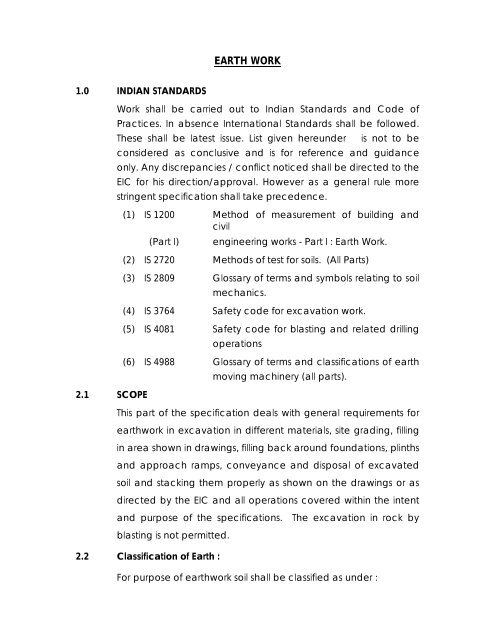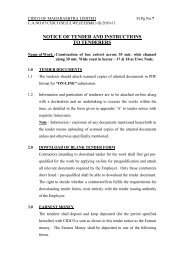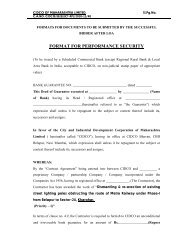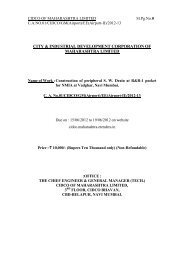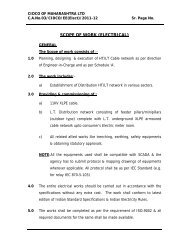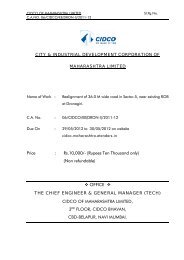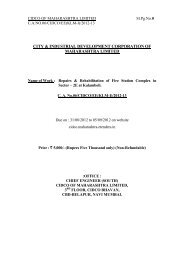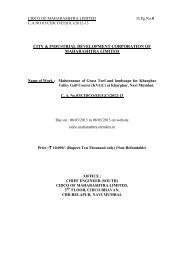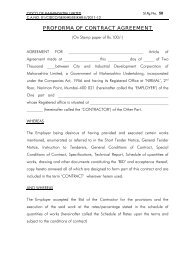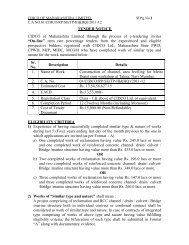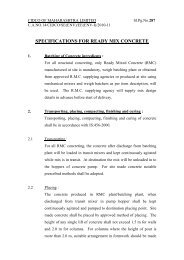EARTH WORK - CIDCO Maharashtra Ltd.
EARTH WORK - CIDCO Maharashtra Ltd.
EARTH WORK - CIDCO Maharashtra Ltd.
Create successful ePaper yourself
Turn your PDF publications into a flip-book with our unique Google optimized e-Paper software.
1.0 INDIAN STANDARDS<br />
2.1 SCOPE<br />
<strong>EARTH</strong> <strong>WORK</strong><br />
Work shall be carried out to Indian Standards and Code of<br />
Practices. In absence International Standards shall be followed.<br />
These shall be latest issue. List given hereunder is not to be<br />
considered as conclusive and is for reference and guidance<br />
only. Any discrepancies / conflict noticed shall be directed to the<br />
EIC for his direction/approval. However as a general rule more<br />
stringent specification shall take precedence.<br />
(1) IS 1200 Method of measurement of building and<br />
civil<br />
(Part I) engineering works - Part I : Earth Work.<br />
(2) IS 2720 Methods of test for soils. (All Parts)<br />
(3) IS 2809 Glossary of terms and symbols relating to soil<br />
mechanics.<br />
(4) IS 3764 Safety code for excavation work.<br />
(5) IS 4081 Safety code for blasting and related drilling<br />
operations<br />
(6) IS 4988 Glossary of terms and classifications of earth<br />
moving machinery (all parts).<br />
This part of the specification deals with general requirements for<br />
earthwork in excavation in different materials, site grading, filling<br />
in area shown in drawings, filling back around foundations, plinths<br />
and approach ramps, conveyance and disposal of excavated<br />
soil and stacking them properly as shown on the drawings or as<br />
directed by the EIC and all operations covered within the intent<br />
and purpose of the specifications. The excavation in rock by<br />
blasting is not permitted.<br />
2.2 Classification of Earth :<br />
For purpose of earthwork soil shall be classified as under :
Loose/soft soil : Any soil which generally yields to the application<br />
of picks and shovels, phawras, rakes or any such ordinary<br />
excavating implements or organic soil, gravel, silt sand, turf<br />
loam, clay, peat etc. fall under this category.<br />
Dense/Hard Soil: Any soil which generally requires the close<br />
application of picks, or jumpers or scarifiers to loosen it. Stiff clay,<br />
gravel and cobble stone etc. fall under this category. (Note :<br />
Cobble stone is the rock fragment usually rounded or semirounded<br />
having maximum diameter in any one direction<br />
between 80 & 300 mm.)<br />
Mud : Mud is a mixture of ordinary soft soil and water in fluid or<br />
weak solid state.<br />
Soft/Disintegrated rock : (Not requiring blasting). This shall<br />
include the type of rock and boulders which may be quarried or<br />
split with crow-bars. Laterite and hard conglomerate also come<br />
under this category.<br />
Hard Rock: (Requiring blasting) : This shall include the type of<br />
rock or boulder which for quarrying or splitting requires the use of<br />
mechanical plant or blasting.<br />
(Note : Boulder is a rock fragment usually rounded by<br />
weathering, disintegration and explosion or abrasion by water or<br />
ice having a maximum dimension in any direction of more than<br />
600 mm).<br />
3.0<br />
Hard Rock : (Requiring blasting but where blasting is prohibited)<br />
under this category shall fall hard rocks which though normally<br />
require blasting for their removal but blasting is prohibited and<br />
excavation has to be done by chiseling, wedging or other<br />
suitable method.<br />
GENERAL<br />
3.1 The Contractor shall furnish all tools, plant, instruments, qualified<br />
supervisory staff, labour, materials, any temporary works,<br />
consumables and everything necessary, whether or not such<br />
items are specifically stated herein, for completion of the job in<br />
accordance with the specification requirements.
3.2 The Contractor shall carry out the surveys of the site before<br />
excavation and set out properly all lines and establish levels for<br />
various works such as earthwork in excavation for grading,<br />
foundations, plinth filling, road drains, cable trenches, pipelines,<br />
culverts, retaining walls etc. Such surveys shall be carried out<br />
taking accurately cross sections of the area perpendicular to the<br />
grid lines at intervals determined by the EIC depending on the<br />
ground profiles. These will be checked by the EIC or his<br />
representative and thereafter properly recorded.<br />
3.3 The excavation shall be done to correct lines and levels. This shall<br />
include where required, proper shoring to maintain excavation<br />
and also the furnishing, erection and maintaining of substantial<br />
barricades around excavations and warning lamps at night for<br />
safety purposes.<br />
3.4 The rates quoted shall include for dumping of excavated<br />
material in regular heaps, bunds, rip rap with regular slopes as<br />
directed by the EIC within the lead specified and leveling the<br />
same so as to provide natural drainage. Rock/soil excavation<br />
shall be properly stacked as directed by the EIC. As and more<br />
resistant materials, forming the casing on the sides and the top.<br />
Rock shall be stacked separately.<br />
4.0 CLEARING<br />
The area to be excavated/filled shall be cleared of all fences,<br />
trees, plant logs, stumps, bush, vegetation, rubbish, slush etc. and<br />
other objectionable matter. If any roots or stumps of trees are<br />
met during excavation, they shall be removed. The material so<br />
removed shall be disposed off as directed by the EIC.<br />
Where earthfill is intended, the area shall be cleared of all<br />
matter/materials before filling commences. No separate<br />
payment shall be made for such clearing works.<br />
5.0 PRECIOUS OBJECTS, RELICS, OBJECTS OF ANTIQUITIES ETC.<br />
All gold, silver, oil, minerals, archaeological and other findings of<br />
importance or other materials of any description and all precious<br />
stones, coins, treasure troves, relics, antiquities and similar things<br />
which may be found in or upon the site shall be the property of
the <strong>CIDCO</strong> and the Contractor shall duly preserve the same to<br />
the satisfaction of the EIC and from time to time deliver the same<br />
to him.<br />
6.0 EXCAVATION FOR STRUCTURES<br />
6.1 Description<br />
Excavation for structures shall consist of removal of materials for<br />
the construction of the foundations of columns, footings, walls<br />
and other similar structures in accordance with the requirements<br />
of this specification and the lines and dimensions shown on the<br />
drawings or as indicated by the EIC. The work shall include all<br />
necessary sheeting, shoring, bracing, draining and pumping; the<br />
removal of all logs, stumps, shrubs and other deleterious matter<br />
and obstruction necessary for placing the foundations, trimming<br />
bottoms of excavation; backfilling, cleaning up the site and<br />
disposal of all surplus materials.<br />
6.2 Setting out :<br />
After the site has been cleared as per clause 4.0 above, the limits<br />
of excavation shall be set out true to lines, curves, slopes, grades<br />
and sections as shown on the drawings or as directed by the EIC.<br />
The Contractor shall provide all labour, survey instruments and<br />
materials such as string, pegs, nails, bamboos, stones, lime,<br />
mortar, concrete, etc. required in connection with the setting out<br />
of works and establishment of bench marks. The Contractor shall<br />
be responsible for the maintenance of bench marks and other<br />
marks and stakes as long as they are required for the work in the<br />
opinion of the EIC.<br />
6.3 Excavation :<br />
a) Excavation shall be taken to the width of the lowest step of<br />
footing or the pile caps and the sides shall be left plumb<br />
where the nature of the soil allow it. Where the nature of<br />
the soil or the depth of excavated trench/pit does not<br />
permit vertical sides, the Contractor at his own expense<br />
shall put up necessary shoring, strutting and planking or<br />
cut slopes to a safe angle or both with due regard to the
safety of personnel and the works and to the satisfaction<br />
of the EIC.<br />
b) The depth to which the excavation is to be carried out<br />
shall be as shown on the drawings unless the type of<br />
material encountered is such as to require changes, in<br />
which case the depth shall be as ordered by the EIC.<br />
c) If contractor prefers for mass excavation of building, he<br />
may do so with the prior permission of EIC. The payment of<br />
excavation and disposal shall be restricted only to<br />
minimum excavation allowed as per mode of payment.<br />
Excavation shall be fully protected against the slide and<br />
slopes.<br />
d) The material suitable for backfilling shall be stacked<br />
separately.
6.3.1 Excavation in all types of soil except rock:<br />
Shall mean excavation in vegetation soil, turf, loam, clay, mud<br />
black-cotton soil, earth murrum (hard or soft) shingle and<br />
generally any material which requires close application of picks<br />
or scarifies to loosen and not affording much resistance to<br />
digging.<br />
6.3.2 Excavation in rock not requiring blasting:<br />
Shall mean excavation in lime stone, sand stone, laterite, hard<br />
conglomerate or other rock which can be quarried or split with<br />
crow bars or, wedges. This shall include unblasted boulders.<br />
6.3.3 Excavation in rock requiring blasting:<br />
Shall mean excavation in hard rock requiring blasting<br />
encountered at places of excavations.<br />
The Contractor shall obtain license from District/Public authorities<br />
for carrying out blasting work as well for obtaining transporting<br />
and storing explosives as per 'Explosives Rules 1940' or as<br />
amended. He shall purchase the explosives, fuses, detonators<br />
etc. only from a licensed dealer. He shall maintain the account of<br />
explosives etc. purchased and used by him. He shall be<br />
responsible for safe custody and proper accounting of explosive<br />
materials. Contractor will be fully responsible for any breach of<br />
the aforesaid Act.<br />
Blasting shall normally be done with gun powder. Dynamite,<br />
Gelatin or any other high explosives shall only be used in special<br />
cases with written permission of the Architect and District<br />
authorities concerned under ‘Explosive Rules'.<br />
Blasting operations shall be carried out under supervision of a<br />
responsible representative of the Contractor during certain hours,<br />
preferably during lunch break as approved in writing by the<br />
Architect. The representative shall be conversant with the rules of<br />
blasting.<br />
Proper precautions for safety of persons shall be taken. Red flags<br />
shall be prominently displayed around the area to be blasted<br />
and all people on work except those who actually light the fuses
6.4<br />
shall be withdrawn to safe distance of not less than 100 meters<br />
from the blast. Blasting shall not be done within 100 metres of an<br />
existing masonry or any other kind of structure unless special<br />
precautions are taken by heavy blanketing etc. The Contractor<br />
shall be responsible for any damage to the person and/or<br />
property either directly or incidental to such blasting including his<br />
employees.<br />
Where blasting is not practical or is prohibited, excavation shall<br />
be done by wedging or chiseling and it shall be restricted to the<br />
quantity required to enable the necessary foundation to be put<br />
in. The item also covers bailing out subsoil water or rainwater<br />
including pumping at any stage of the work, shoring strutting etc.<br />
Dewatering and Protection :<br />
Where water is met with in excavation due to stream flow,<br />
seepage, springs, rain or other reasons, the Contractor shall take<br />
adequate measures such as bailing, pumping, construction of<br />
diversion channels, drainage channels, bunds, cofferdams and<br />
other necessary works to keep the foundation trenches/pits dry<br />
when so required and to keep the green concrete / masonry<br />
against damage by erosion or sudden rise of water level. The<br />
method to be adopted in this regard and other details thereof<br />
shall be left to the choice of the Contractor but subject to the<br />
approval of the EIC. Approval of the EIC shall, however, not<br />
relieve the Contractor of his responsibility for the adequacy of<br />
dewatering and protection arrangements and the safety of the<br />
works.<br />
Where cofferdams are required, these shall be carried to<br />
adequate depths and heights, be safely designed and<br />
constructed and be made as watertight as is necessary for<br />
facilitating construction to be carried out inside them. The interior<br />
dimensions of the cofferdams shall be such as to give sufficient<br />
clearance for constructions and inspection and to permit<br />
installation of pumping machinery inside the enclosed area.<br />
Pumping from inside of any foundation enclosure shall be done in<br />
such a manner as to preclude the possibility for the movement of
water through any freshly placed concrete. No pumping shall be<br />
permitted during the placing of concrete or for any period of at<br />
least 24 hours thereafter, unless it is done from a suitable sump<br />
separated from the concrete work by a water tight wall or similar<br />
means. At the discretion of the Contractor shall take all<br />
precautions in diverting channels and in discharging the drained<br />
water so as not to cause damage to the works or to the adjoining<br />
property.<br />
6.5 Preparation of Foundation :<br />
The bottom of the foundation shall be leveled both longitudinally<br />
and transversally or stepped as directed by the EIC. Before the<br />
footing is laid, the surface shall be slightly watered and rammed.<br />
In the event of the excavation having been made deeper than<br />
that shown on the drawing or as otherwise ordered by the EIC,<br />
the extra depth shall be made up with concrete or masonry of<br />
the foundation grade at the cost of the Contractor. Ordinary<br />
filling shall not be used for the purpose to bring the foundation to<br />
level.<br />
When rock or other hard strata is encountered, it shall be freed of<br />
all loose and soft materials, cleaned and cut to a firm surface<br />
either level, stepped, or serrated as directed by the EIC. All<br />
seams shall be cleaned out and filled with cement mortar or<br />
grout to the satisfaction of the EIC.<br />
6.6 Slips and Blows :<br />
If there are any slips or blows in the excavation, these shall be<br />
removed by the Contractor at his own cost.<br />
6.7 Backfilling :<br />
To the extent available, selected surplus soil from the excavation<br />
shall be used as backfill. Fill materials shall be free from clods,<br />
salts, sulphates, organic or other foreign materials. All clods of<br />
earth shall be broken or removed. Where excavated material is<br />
mostly rock, the boulders shall be broken into pieces not larger<br />
than 250 mm size mixed with properly graded fine materials
consisting of murrum or earth to fill up the voids and the mixture<br />
used for filling.<br />
If any selected fill material is required to be borrowed, the<br />
Contractor shall make his own arrangement for bringing the<br />
material from outside borrow pits. The material sources shall be<br />
subject to the prior approval of the EIC. The Contractor shall<br />
make necessary access roads to such borrow areas at his own<br />
cost, if such access roads do not exist. The Contractor shall make<br />
necessary payment of royalty charges with the concern Authority<br />
for obtaining quarry permit.<br />
The selected fill material shall be approved quality murrum<br />
having liquid limit not more than 40 and plasticity index not more<br />
than 20 and minimum dry density not less than 1700 kg per cu.m.<br />
Backfilling of the foundation trenches/pits shall be done as soon<br />
as the foundation work has been completed to the satisfaction<br />
of the EIC and measured but not earlier than the full setting of the<br />
concrete or masonry of the foundation. Backfilling shall be<br />
carried out in such a manner as not to cause undue thrust on any<br />
part of the structure. Backfilling shall be done in space around<br />
the foundations after clearing it of all debris and in layers of 250<br />
mm loose thickness, watered and compacted to the satisfaction<br />
of the EIC and upto the original surface.<br />
6.8 Disposal of Surplus Excavated Materials:<br />
All the excavated materials shall be the property of the <strong>CIDCO</strong><br />
where the excavated material is directed to be used in the<br />
construction of the works for the general grading, plinth filling or<br />
embankments, the operations shall be arranged in such a<br />
manner that the capacity for cutting, haulage and compaction<br />
are nearly the same.<br />
All hard materials such as hard murrum, rubble etc. not intended<br />
for filling in foundations, plinth or embankments, shall be stacked<br />
neatly for future use as directed by the EIC within the lead<br />
specified. Unsuitable or surplus materials not intended for use in<br />
part of the works or for reuse shall be disposed of as directed by<br />
the EIC.
7.0 MEASUREMENT AND RATES:<br />
The measurement shall be generally conforming to IS:1200, Part-I<br />
unless otherwise specified. Measurement for excavation of<br />
foundations and footing shall be as required for the exact width,<br />
length and depth as shown of figured on the drawings or as<br />
may be directed by the EIC. If taken out to a greater width,<br />
length or depth than shown or required, the extra work<br />
occasioned thereby shall be done at the Contractor's expenses.<br />
The dimensions of the trenches and pits shall be measured<br />
correct to the nearest cm. and cubical contents worked out in<br />
cubic metres, correct to two places of decimal.<br />
Measurements of filling excavated earth or sand in plinth or under<br />
floors: depth of consolidated earth fillings, shall be measured for<br />
the purpose of payments. The dimensions of the fillings shall be<br />
measured correct to the nearest cm. and cubical contents<br />
worked out in cubic metres correct to the two places of decimal.<br />
Rate for earth work shall include the following :<br />
a) Excavation and disposing of all excavated materials as<br />
specified.<br />
b) Setting out works, profiles etc.<br />
c) Site clearance such as cleaning of rank vegetation, shrubs,<br />
brushwood.<br />
d) Forming (or leaving)" dead mean" or "tell tales" and their<br />
removals after measurement<br />
e) Bailing out water in excavation from rains, sub-soil water<br />
etc.<br />
f) Protection and temporarily supporting of existing services,<br />
of pipes, water mains, cables etc. met within the course of<br />
excavation. Care shall be taken not to disturb electric and<br />
communication cables. Removal of such cables, if<br />
necessary, shall be arranged by the EIC.<br />
g) Forming (or leaving) steps in sides of deep trenches and<br />
their removal.
h) Removing slips or falls in excavation including necessary<br />
shoring & strutting.<br />
i) Fencing and/or other suitable measures for protection<br />
against risk of accidents as approved by the EIC.<br />
j) Excavation for insertion of planking and strutting where<br />
required, and<br />
k) Backfilling the trenches foundations (sides of footings) with<br />
selected excavated materials.<br />
l) Payment of necessary royalty charges for excavation and<br />
contractor’s material brought from outside.<br />
8.0 <strong>EARTH</strong> FILLING:<br />
General : Filling shall be done with good earth, murrum, stone<br />
chips or disintegrated building debris. it shall be free from salts,<br />
organic matter, black cotton soil or slushed earth and<br />
combustible material. All clods shall be broken.<br />
a) Filling in Plinth :<br />
Filling shall be done in layer not exceeding 20 cm, watered<br />
and consolidated by ramming with iron or wooden<br />
rammers weighing 7 to 8 kg., and having base 20 cm.<br />
Square or 20 cm. diameter. When the filling reaches the<br />
finished level, surface shall be kept flooded with water for<br />
at least 24 hours, allowed to dry and then rammed and<br />
consolidated, after making good any settlement in order<br />
to avoid settlement at a later stage. Special care shall be<br />
taken to pack earth under plinth beams and column<br />
corners.<br />
Finished level of filling shall be kept to a slope intended to<br />
be given to the floor.
) Filling for Plot Development<br />
Filling shall be done in layer of 30 cm. when filling reaches<br />
the required level, top layer shall be dressed to proper<br />
section, grade and camber and rolled by 8 to 10 tons.<br />
power roller and adequately watered to aid compaction.<br />
9.0 DRY RUBBLE PACKING:<br />
Ground shall first be leveled up and thoroughly consolidated by<br />
means of heavy log hammer or frog rams. Rubble of specified<br />
thickness shall be laid and set with hand. It shall be consolidated<br />
either by hand roller or wooden log hammer; free use of water<br />
being made during consolidation. All hollows and interstices after<br />
consolidation shall be filled with quarry spalls, stone chips, etc.<br />
and the packing blinded with stone grit and watered and<br />
consolidated by log hammer.<br />
10.0 LEVELLING COURSE:<br />
It shall be M-20 grade either plain cement concrete as stipulated<br />
in the relevant items and placed in position conforming line and<br />
level shown on the drawing and compacted by approved<br />
means and cured adequately.<br />
11.0 ANTI-TERMITE TREATMENT<br />
11.1 Indian Standards<br />
Indian Standards to be followed are<br />
1) IS 4015 (Part-I & II)- Guide for handling cases of pesticide<br />
poisoning.<br />
2) IS 6313 (Part-I) - Code of practice for Anti- termite<br />
measures in buildings constructional<br />
measures<br />
3) IS 6313 (Part - II) - Code of practice for anti-termite<br />
measures in Building (pre<br />
constructional chemical treatment)<br />
4) IS 8944 - Specification for Chloropyrifos<br />
Emulsified concentrates.<br />
5) IS 632 - Specification for Lindane
11.2 Materials<br />
One of the following chemicals in water emulsion shall be used
11.2.1 For mound treatment<br />
Chemical<br />
a. Cholopyrifos emulsifiable<br />
concentrate<br />
Relevant<br />
Indian<br />
Standard<br />
Concentration<br />
By Volume<br />
IS : 8944 1.0%<br />
b. Lindane IS : 632 1.0%<br />
11.2.2 For soil treatment<br />
Chemical<br />
a. Cholopyrifos emulsifiable<br />
concentrate<br />
Relevant<br />
Indian<br />
Standard<br />
Concentration<br />
By Volume<br />
IS : 8944 1.0%<br />
b. Lindane IS : 632 1.0%<br />
11.2.3 Providing, pre-constructional Anti termite treatment by treating<br />
the bottom surface and the sides of exaction in soil with the plinth<br />
beam at the rate of 3 litres of emulsion concentrate of one<br />
percent concentration of CHLOROPYRIFOS 20% F.C.ISI approved<br />
conforming (I.S. 8944) i.e. by diluting 5 ltr. of chloropyrifoc 20% EC<br />
with 95 ltr. of water) and spraying by high volume sprayer per<br />
sq.mtr. surface area with 10 years guarantee bond as per I.S.<br />
6313 (Part II 1971).<br />
11.2.4 Providing exhaustive Anti termite treatment to the sides of flooring<br />
by injecting 1% of chloropyrifol emulsion concentrate at the rate<br />
of 50ml per hole of 6 mm dia. Drilled at a distance of 30 cms<br />
centre to centre or more as per requirement and sealing the<br />
same with proper filling with two years guarantee bond as per I.S.<br />
6313 (Part III) of 1981.<br />
11.2.5 Providing exhaustive Anti-termite treatment around the periphery<br />
by excavating trenches of 20 cms. Width and exposing the side
of columns and plinth beams upto a depth of 300 mm by<br />
injecting one percent of cholordane emulsion concentrate at<br />
the rate of 2.25 litres per running metre or more as per<br />
requirement with two years guarantee bond as per I.S. 6313 (Part<br />
III) of 1971.<br />
11.3.0 <strong>WORK</strong>MANSHIP<br />
11.3.1 Conditions of formation<br />
Barrier shall be complete and continuous under the whole of the<br />
structure to be protected. All foundation shall be fully surrounded<br />
by and in close contact with the barrier of treated soil. Each part<br />
of the area treated shall receive the prescribed dosage of<br />
chemical.<br />
11.3.2 Time of application<br />
Soil treatment should start when foundation trenches and pits are<br />
ready to take mass concrete in foundations. Laying of mass<br />
concrete should start when the chemical emulsion has been<br />
absorbed by the soil and surface is quite dry. Treatment should<br />
not be carried out when it is raining or when the soil is wet with<br />
rain or sub-soil water. The foregoing applies also in the case of<br />
treatment to the filled earth surface within the plinth area before<br />
laying the sub-grade for the floor.<br />
11.3.3 Disturbance<br />
Once formed, treated soil barriers shall not be disturbed. If, by<br />
chance, treated soil barriers are disturbed, immediate steps shall<br />
be taken to restore the continuity and completeness of the<br />
barriers-system.<br />
11.4.0 Termite mound treatment<br />
If termite mounds are found within the plinth area, these shall be<br />
destroyed by pouring into the mounds at several places, after<br />
breaking open the earthen structure, and making holes with<br />
crow-bars, at the rate of approximately 4 litres of emulsion per<br />
cubic meter of mound.<br />
11.5.0 Soil Treatment
11.5.1 Treatment of column pits foundation, trenches and basement<br />
excavations:<br />
The bottom surface and the sides (upto a height of 300 mm<br />
above concrete foundation level) of the excavations made for<br />
column pits, wall trenches and basements shall be treated with<br />
the chemical at the rate of 5 litres per sqm of surface area. After<br />
the column foundation and retaining walls of the basement<br />
come up, the back fill in immediate contact with the foundation<br />
structure shall be treated at the rate of 15 litres per sqm of the<br />
vertical surface of the sub-structure for each side. If water is used<br />
for ramming the earth fill the chemical treatment shall be carried<br />
out after ramming operation is done by rodding the earth at 150<br />
mm centers close to wall surface and spraying the chemical with<br />
the above dose. As earth is filled in layers the treatment shall be<br />
carried out in similar stages. The chemical emulsion shall be<br />
directed towards the concrete or masonry surfaces of the<br />
columns and walls so that earth in contact with these surfaces is<br />
well treated with the chemicals. In the case of RCC framed<br />
structure with columns and plinth beams and RCC basements,<br />
the treatment shall start at the depth of 500 mm below ground<br />
level except when such ground level is raised or lowered by filling<br />
or cutting after the foundations have been cast. In such cases,<br />
the depth 500mm shall be determined from the new soil level<br />
resulting from filling or cutting mentioned above. From this depth<br />
the back fill around the columns beams and RCC basement wall<br />
shall be treated at the rate of 15 liters per sqm of vertical surface.<br />
The other details of treatment shall be as detailed below:<br />
11.5.2 Treatment for expansion joints<br />
Expansion joints at ground floor level are one of the biggest<br />
hazards for termite infestation. The soil beneath these joints<br />
should receive special attention when the treatment under para<br />
11.2.3 to 11.2.5 is carried out. This treatment should be<br />
supplemented by treating through the expansion joint after the<br />
sub-grade has been laid at the rate of 2 litres per linear meter.<br />
11.6.0 Spraying Equipment
A pressure pump shall be used to carry out spraying operations to<br />
facilitate uniform spraying and penetration of chemical into the<br />
earth. The chemicals, concentration and dosage for horizontal<br />
and vertical surfaces are based on the IS code of practice for<br />
Anti-termite measures in Buildings. IS 6313 (Part-II).<br />
11.7.0 Safety Precautions<br />
All chemicals specified are poisonous and hazardous to health.<br />
Persons handling or using should be warned and trained to take<br />
precautions as detailed by manufacturer and laid down in IS.<br />
Also persons working should be educated to take 1st aid as per IS<br />
4015 part (I) and part (II).<br />
11.8.0 Free Service Guarantee<br />
The contractor shall note that termite proofing work, is subject to<br />
a free service guarantee from the date of completion of the<br />
treatment. The contractor shall give an undertaking on Rs. 100/-<br />
Stamp Paper in writing to the effect that during the guarantee<br />
period any infestation of subterranean termites will be eradicated<br />
and necessary treatment carried out to prevent re-infestation,<br />
free of cost to the employer. The guarantee shall allow a<br />
minimum period of 10 (ten) years for pre-constructional<br />
treatment.<br />
Contractor must ensure that the work will be done through the<br />
professional Pest Control operator. They should be members of<br />
National Pest Control Association of USA, or Indian Pest Control<br />
Association or any other recognised professional body. They<br />
should furnish a list of Termite Control jobs carried out by them<br />
successfully for Government Department, Statutory bodies or<br />
large private organisations to prove that they are capable of<br />
handling anti termite work.<br />
Signature of Tenderer<br />
Date.:<br />
Additional Chief<br />
Engineer(I&NT)<br />
Date.:


